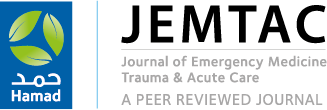-
oa Comparison between retromandibular approach versus transmasseteric anteroparotid approach in open reduction and internal fixation of mandibular condylar fractures—A prospective observational study
- Source: Journal of Emergency Medicine, Trauma and Acute Care, Volume 2025, Issue 2, Apr 2025, 16
-
- 02 October 2024
- 27 January 2025
- 08 April 2025
Abstract
Purpose: To compare the efficacy of retromandibular approach (RM) to transmasseteric anteroparotid approach (TMAP) in open reduction and internal fixation of mandibular condylar fractures using various clinical parameters. The parameters evaluated include duration (time taken from incision to reach the fractured site, accessibility to reach the fractured site (intraoperative), facial nerve palsy, sialocele, and scarring (post-operative).
Materials and Methods: The sample size was 26 (13 per group). The study was conducted in patients with condylar fractures planned for open reduction and internal fixation. The choice of approaches was RM and TMAP. The post-operative parameters were analyzed during the first week, first month, and third month. The study was done between 2018 and 2020. Patients were randomly assigned to the groups. Group I contained RM and Group II had TMAP.
Results: On comparing efficacy, each approach was versatile in its own way. Considering duration no statistically significant difference was observed. In terms of accessibility there was no statistically significant difference but TMAP offered a better access compared to RM. A very minimal difference was observed in post-operative features like facial nerve palsy, sialocele, and scarring but none reached statistical significance. Only scaring pertaining to the length of the incision in TMAP was statistically significant. Considering RM, it was the fastest, easiest to reach the fractured site and more suitable for reducing medially displaced condyle fractures. TMAP credits with respect to direct access to the fracture site, placement of screws perpendicular to the fractured site, less chance of facial nerve palsy but resulted in inconspicuous scar. It was observed that both approaches had their own versatility, including good exposure and accessibility to fracture site. The choice depends on the type of condyle fracture and convenience of the surgeon.
Conclusion: Currently, very little has been published pertaining to the comparison between RM and TMAP for condyle fractures. RM resulted in less scarring, providing a better convenience and accessibility for reducing medially displaced subcondyle fracture. TMAP offered a more direct exposure of the fracture site with a better direct reduction, ease of placement of plate and screws with a favorable access.



